International Trade Finance and Investment: UK Economy Report
VerifiedAdded on 2023/01/03
|12
|3722
|8
Report
AI Summary
This report delves into the realm of international trade finance and investment, focusing primarily on the UK economy and its relationship with Japan. It begins by outlining the background of financial markets, including bond markets, money markets, and the forex market, emphasizing the UK's significant role as a global financial hub. The report then explores capital allocation within both the domestic (UK) and international markets, detailing infrastructure investments, the importance of MSMEs, and strategies like mergers, acquisitions, and dividend payments. A key section evaluates the Japanese economy, providing an overview of its economic standing, international trade activities, and key economic indicators. Finally, the report critically examines the challenges associated with industrialization and trade policies, offering a comprehensive analysis of the factors influencing international trade and investment dynamics. The report also highlights the importance of financial markets in facilitating trade, and the challenges faced by the UK and Japan in maintaining their economic positions.
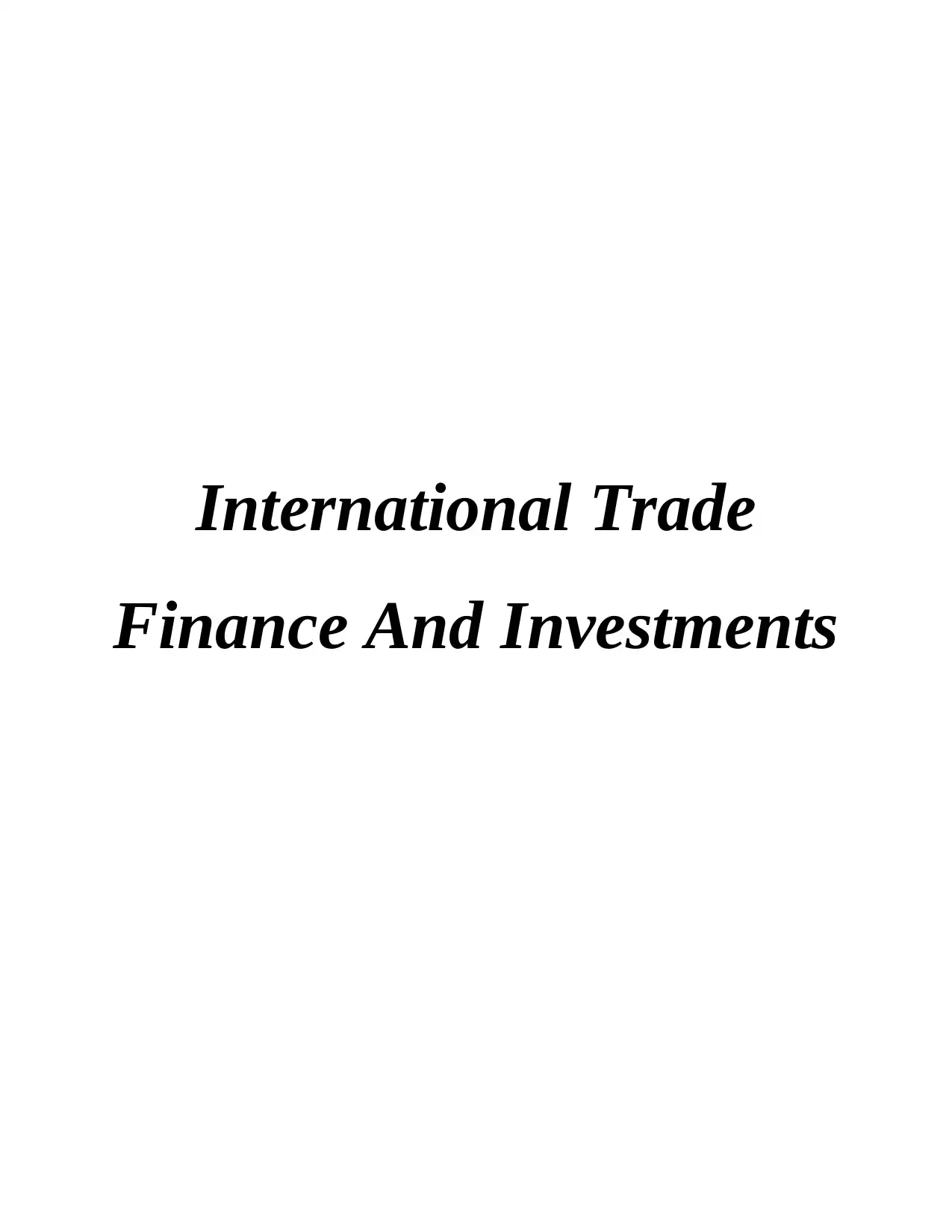
International Trade
Finance And Investments
Finance And Investments
Paraphrase This Document
Need a fresh take? Get an instant paraphrase of this document with our AI Paraphraser

Table of Contents
INTRODUCTION...........................................................................................................................4
TASK 1............................................................................................................................................4
Background of financial markets:................................................................................................4
Capital Allocation within Domestic Economy:...........................................................................5
Capital Allocation within International Markets:........................................................................6
TASK 2............................................................................................................................................7
Evaluation of Japan economy related to financial trading:..........................................................7
Critical evaluation of challenges in relation to Industrialisation and trade policies:...................8
CONCLUSION..............................................................................................................................10
REFERENCES..............................................................................................................................11
INTRODUCTION...........................................................................................................................4
TASK 1............................................................................................................................................4
Background of financial markets:................................................................................................4
Capital Allocation within Domestic Economy:...........................................................................5
Capital Allocation within International Markets:........................................................................6
TASK 2............................................................................................................................................7
Evaluation of Japan economy related to financial trading:..........................................................7
Critical evaluation of challenges in relation to Industrialisation and trade policies:...................8
CONCLUSION..............................................................................................................................10
REFERENCES..............................................................................................................................11
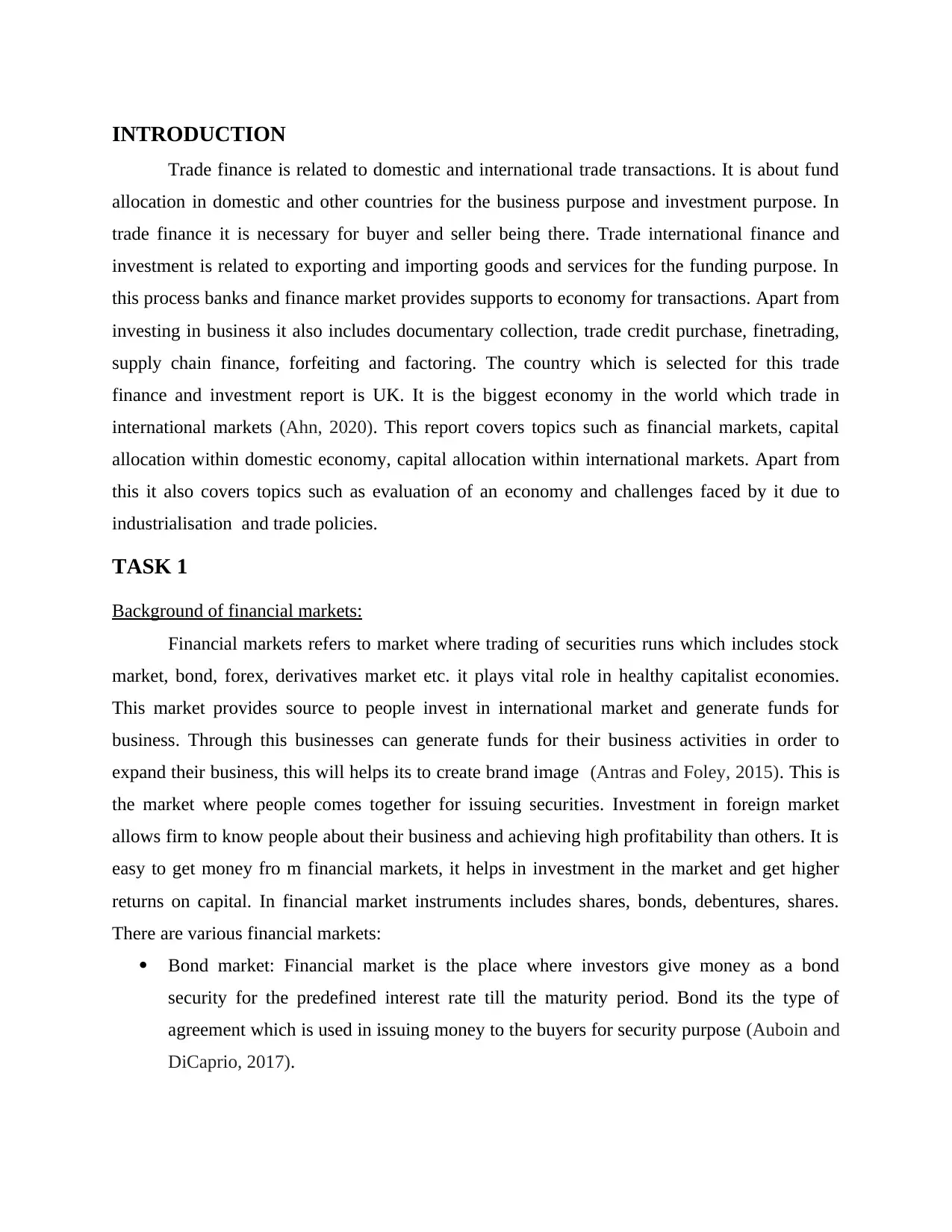
INTRODUCTION
Trade finance is related to domestic and international trade transactions. It is about fund
allocation in domestic and other countries for the business purpose and investment purpose. In
trade finance it is necessary for buyer and seller being there. Trade international finance and
investment is related to exporting and importing goods and services for the funding purpose. In
this process banks and finance market provides supports to economy for transactions. Apart from
investing in business it also includes documentary collection, trade credit purchase, finetrading,
supply chain finance, forfeiting and factoring. The country which is selected for this trade
finance and investment report is UK. It is the biggest economy in the world which trade in
international markets (Ahn, 2020). This report covers topics such as financial markets, capital
allocation within domestic economy, capital allocation within international markets. Apart from
this it also covers topics such as evaluation of an economy and challenges faced by it due to
industrialisation and trade policies.
TASK 1
Background of financial markets:
Financial markets refers to market where trading of securities runs which includes stock
market, bond, forex, derivatives market etc. it plays vital role in healthy capitalist economies.
This market provides source to people invest in international market and generate funds for
business. Through this businesses can generate funds for their business activities in order to
expand their business, this will helps its to create brand image (Antras and Foley, 2015). This is
the market where people comes together for issuing securities. Investment in foreign market
allows firm to know people about their business and achieving high profitability than others. It is
easy to get money fro m financial markets, it helps in investment in the market and get higher
returns on capital. In financial market instruments includes shares, bonds, debentures, shares.
There are various financial markets:
Bond market: Financial market is the place where investors give money as a bond
security for the predefined interest rate till the maturity period. Bond its the type of
agreement which is used in issuing money to the buyers for security purpose (Auboin and
DiCaprio, 2017).
Trade finance is related to domestic and international trade transactions. It is about fund
allocation in domestic and other countries for the business purpose and investment purpose. In
trade finance it is necessary for buyer and seller being there. Trade international finance and
investment is related to exporting and importing goods and services for the funding purpose. In
this process banks and finance market provides supports to economy for transactions. Apart from
investing in business it also includes documentary collection, trade credit purchase, finetrading,
supply chain finance, forfeiting and factoring. The country which is selected for this trade
finance and investment report is UK. It is the biggest economy in the world which trade in
international markets (Ahn, 2020). This report covers topics such as financial markets, capital
allocation within domestic economy, capital allocation within international markets. Apart from
this it also covers topics such as evaluation of an economy and challenges faced by it due to
industrialisation and trade policies.
TASK 1
Background of financial markets:
Financial markets refers to market where trading of securities runs which includes stock
market, bond, forex, derivatives market etc. it plays vital role in healthy capitalist economies.
This market provides source to people invest in international market and generate funds for
business. Through this businesses can generate funds for their business activities in order to
expand their business, this will helps its to create brand image (Antras and Foley, 2015). This is
the market where people comes together for issuing securities. Investment in foreign market
allows firm to know people about their business and achieving high profitability than others. It is
easy to get money fro m financial markets, it helps in investment in the market and get higher
returns on capital. In financial market instruments includes shares, bonds, debentures, shares.
There are various financial markets:
Bond market: Financial market is the place where investors give money as a bond
security for the predefined interest rate till the maturity period. Bond its the type of
agreement which is used in issuing money to the buyers for security purpose (Auboin and
DiCaprio, 2017).
⊘ This is a preview!⊘
Do you want full access?
Subscribe today to unlock all pages.

Trusted by 1+ million students worldwide
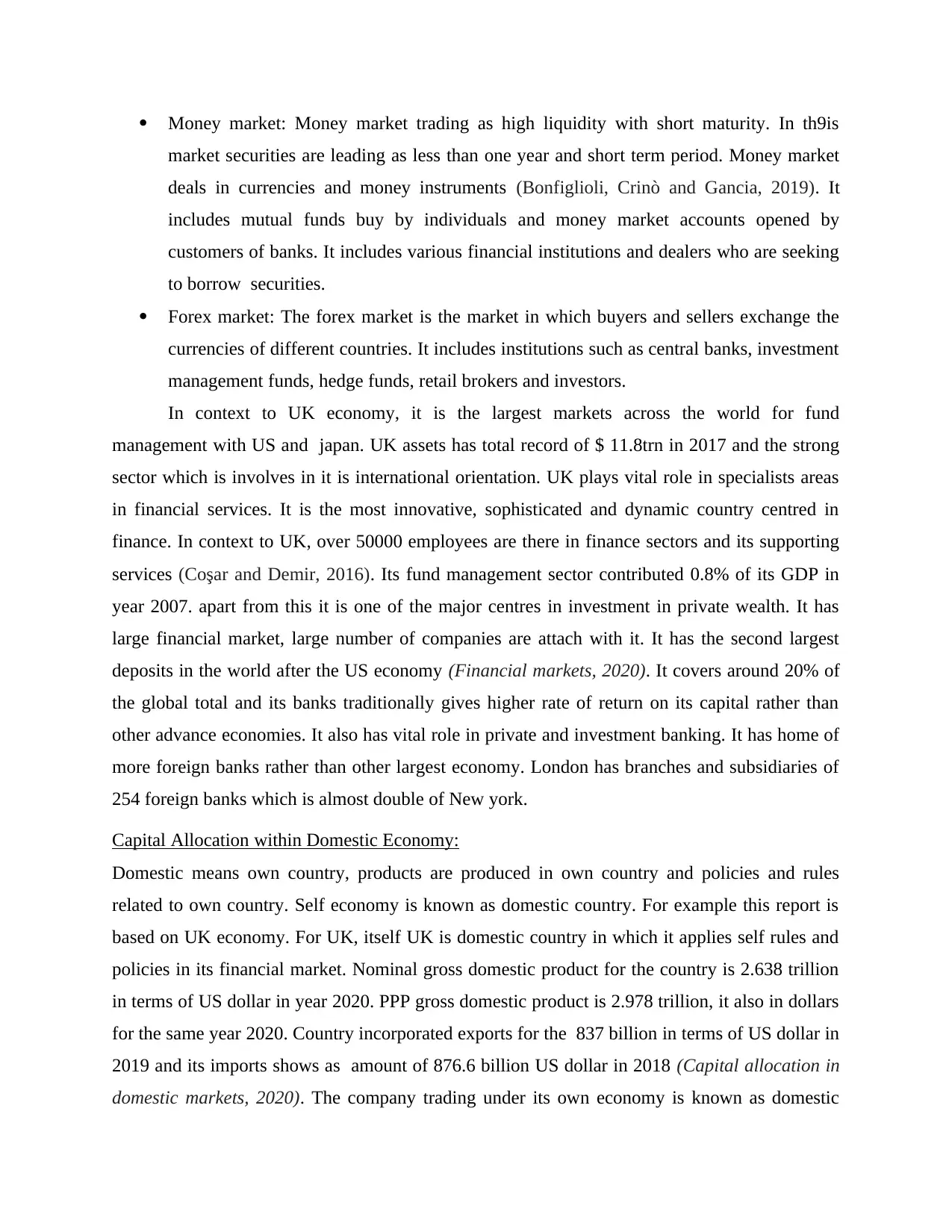
Money market: Money market trading as high liquidity with short maturity. In th9is
market securities are leading as less than one year and short term period. Money market
deals in currencies and money instruments (Bonfiglioli, Crinò and Gancia, 2019). It
includes mutual funds buy by individuals and money market accounts opened by
customers of banks. It includes various financial institutions and dealers who are seeking
to borrow securities.
Forex market: The forex market is the market in which buyers and sellers exchange the
currencies of different countries. It includes institutions such as central banks, investment
management funds, hedge funds, retail brokers and investors.
In context to UK economy, it is the largest markets across the world for fund
management with US and japan. UK assets has total record of $ 11.8trn in 2017 and the strong
sector which is involves in it is international orientation. UK plays vital role in specialists areas
in financial services. It is the most innovative, sophisticated and dynamic country centred in
finance. In context to UK, over 50000 employees are there in finance sectors and its supporting
services (Coşar and Demir, 2016). Its fund management sector contributed 0.8% of its GDP in
year 2007. apart from this it is one of the major centres in investment in private wealth. It has
large financial market, large number of companies are attach with it. It has the second largest
deposits in the world after the US economy (Financial markets, 2020). It covers around 20% of
the global total and its banks traditionally gives higher rate of return on its capital rather than
other advance economies. It also has vital role in private and investment banking. It has home of
more foreign banks rather than other largest economy. London has branches and subsidiaries of
254 foreign banks which is almost double of New york.
Capital Allocation within Domestic Economy:
Domestic means own country, products are produced in own country and policies and rules
related to own country. Self economy is known as domestic country. For example this report is
based on UK economy. For UK, itself UK is domestic country in which it applies self rules and
policies in its financial market. Nominal gross domestic product for the country is 2.638 trillion
in terms of US dollar in year 2020. PPP gross domestic product is 2.978 trillion, it also in dollars
for the same year 2020. Country incorporated exports for the 837 billion in terms of US dollar in
2019 and its imports shows as amount of 876.6 billion US dollar in 2018 (Capital allocation in
domestic markets, 2020). The company trading under its own economy is known as domestic
market securities are leading as less than one year and short term period. Money market
deals in currencies and money instruments (Bonfiglioli, Crinò and Gancia, 2019). It
includes mutual funds buy by individuals and money market accounts opened by
customers of banks. It includes various financial institutions and dealers who are seeking
to borrow securities.
Forex market: The forex market is the market in which buyers and sellers exchange the
currencies of different countries. It includes institutions such as central banks, investment
management funds, hedge funds, retail brokers and investors.
In context to UK economy, it is the largest markets across the world for fund
management with US and japan. UK assets has total record of $ 11.8trn in 2017 and the strong
sector which is involves in it is international orientation. UK plays vital role in specialists areas
in financial services. It is the most innovative, sophisticated and dynamic country centred in
finance. In context to UK, over 50000 employees are there in finance sectors and its supporting
services (Coşar and Demir, 2016). Its fund management sector contributed 0.8% of its GDP in
year 2007. apart from this it is one of the major centres in investment in private wealth. It has
large financial market, large number of companies are attach with it. It has the second largest
deposits in the world after the US economy (Financial markets, 2020). It covers around 20% of
the global total and its banks traditionally gives higher rate of return on its capital rather than
other advance economies. It also has vital role in private and investment banking. It has home of
more foreign banks rather than other largest economy. London has branches and subsidiaries of
254 foreign banks which is almost double of New york.
Capital Allocation within Domestic Economy:
Domestic means own country, products are produced in own country and policies and rules
related to own country. Self economy is known as domestic country. For example this report is
based on UK economy. For UK, itself UK is domestic country in which it applies self rules and
policies in its financial market. Nominal gross domestic product for the country is 2.638 trillion
in terms of US dollar in year 2020. PPP gross domestic product is 2.978 trillion, it also in dollars
for the same year 2020. Country incorporated exports for the 837 billion in terms of US dollar in
2019 and its imports shows as amount of 876.6 billion US dollar in 2018 (Capital allocation in
domestic markets, 2020). The company trading under its own economy is known as domestic
Paraphrase This Document
Need a fresh take? Get an instant paraphrase of this document with our AI Paraphraser
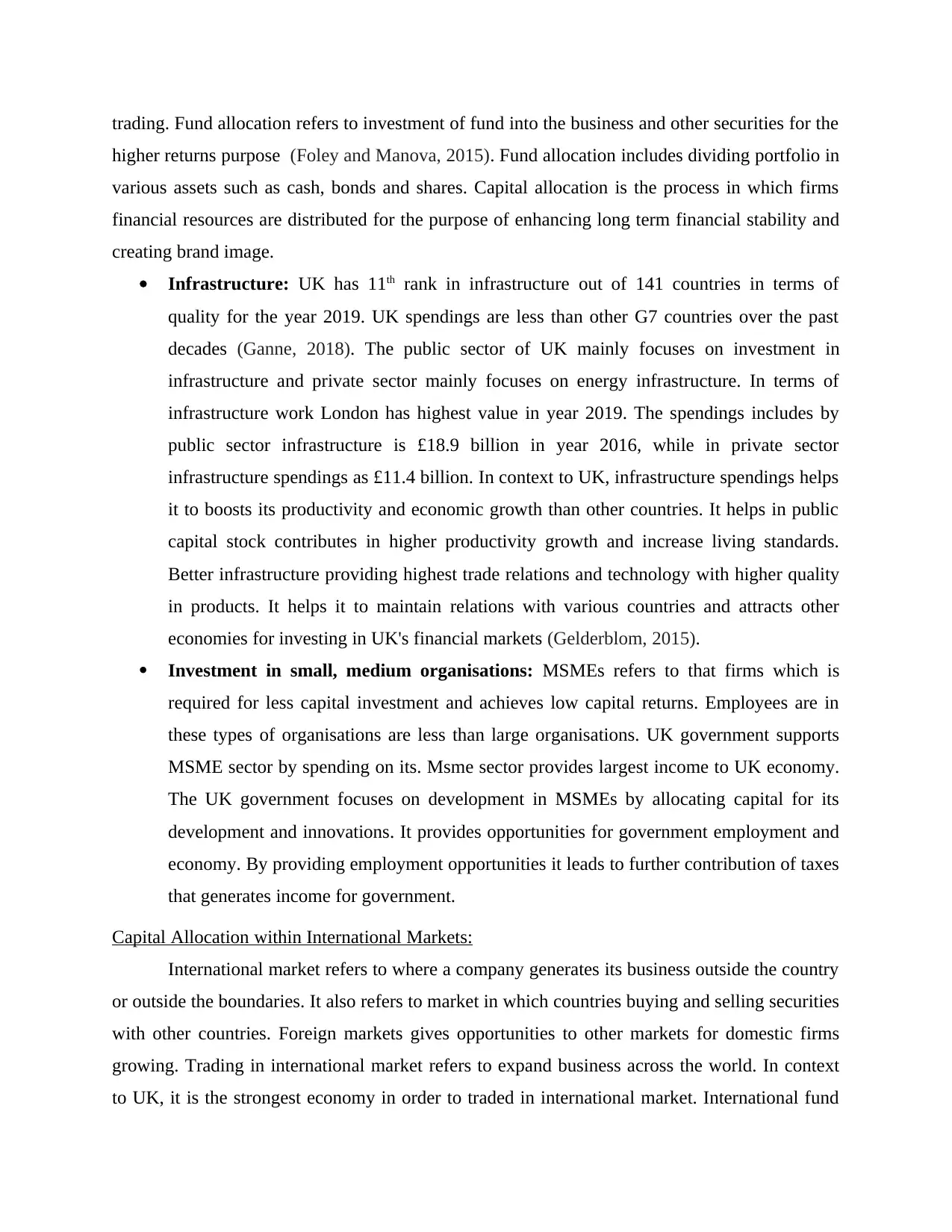
trading. Fund allocation refers to investment of fund into the business and other securities for the
higher returns purpose (Foley and Manova, 2015). Fund allocation includes dividing portfolio in
various assets such as cash, bonds and shares. Capital allocation is the process in which firms
financial resources are distributed for the purpose of enhancing long term financial stability and
creating brand image.
Infrastructure: UK has 11th rank in infrastructure out of 141 countries in terms of
quality for the year 2019. UK spendings are less than other G7 countries over the past
decades (Ganne, 2018). The public sector of UK mainly focuses on investment in
infrastructure and private sector mainly focuses on energy infrastructure. In terms of
infrastructure work London has highest value in year 2019. The spendings includes by
public sector infrastructure is £18.9 billion in year 2016, while in private sector
infrastructure spendings as £11.4 billion. In context to UK, infrastructure spendings helps
it to boosts its productivity and economic growth than other countries. It helps in public
capital stock contributes in higher productivity growth and increase living standards.
Better infrastructure providing highest trade relations and technology with higher quality
in products. It helps it to maintain relations with various countries and attracts other
economies for investing in UK's financial markets (Gelderblom, 2015).
Investment in small, medium organisations: MSMEs refers to that firms which is
required for less capital investment and achieves low capital returns. Employees are in
these types of organisations are less than large organisations. UK government supports
MSME sector by spending on its. Msme sector provides largest income to UK economy.
The UK government focuses on development in MSMEs by allocating capital for its
development and innovations. It provides opportunities for government employment and
economy. By providing employment opportunities it leads to further contribution of taxes
that generates income for government.
Capital Allocation within International Markets:
International market refers to where a company generates its business outside the country
or outside the boundaries. It also refers to market in which countries buying and selling securities
with other countries. Foreign markets gives opportunities to other markets for domestic firms
growing. Trading in international market refers to expand business across the world. In context
to UK, it is the strongest economy in order to traded in international market. International fund
higher returns purpose (Foley and Manova, 2015). Fund allocation includes dividing portfolio in
various assets such as cash, bonds and shares. Capital allocation is the process in which firms
financial resources are distributed for the purpose of enhancing long term financial stability and
creating brand image.
Infrastructure: UK has 11th rank in infrastructure out of 141 countries in terms of
quality for the year 2019. UK spendings are less than other G7 countries over the past
decades (Ganne, 2018). The public sector of UK mainly focuses on investment in
infrastructure and private sector mainly focuses on energy infrastructure. In terms of
infrastructure work London has highest value in year 2019. The spendings includes by
public sector infrastructure is £18.9 billion in year 2016, while in private sector
infrastructure spendings as £11.4 billion. In context to UK, infrastructure spendings helps
it to boosts its productivity and economic growth than other countries. It helps in public
capital stock contributes in higher productivity growth and increase living standards.
Better infrastructure providing highest trade relations and technology with higher quality
in products. It helps it to maintain relations with various countries and attracts other
economies for investing in UK's financial markets (Gelderblom, 2015).
Investment in small, medium organisations: MSMEs refers to that firms which is
required for less capital investment and achieves low capital returns. Employees are in
these types of organisations are less than large organisations. UK government supports
MSME sector by spending on its. Msme sector provides largest income to UK economy.
The UK government focuses on development in MSMEs by allocating capital for its
development and innovations. It provides opportunities for government employment and
economy. By providing employment opportunities it leads to further contribution of taxes
that generates income for government.
Capital Allocation within International Markets:
International market refers to where a company generates its business outside the country
or outside the boundaries. It also refers to market in which countries buying and selling securities
with other countries. Foreign markets gives opportunities to other markets for domestic firms
growing. Trading in international market refers to expand business across the world. In context
to UK, it is the strongest economy in order to traded in international market. International fund
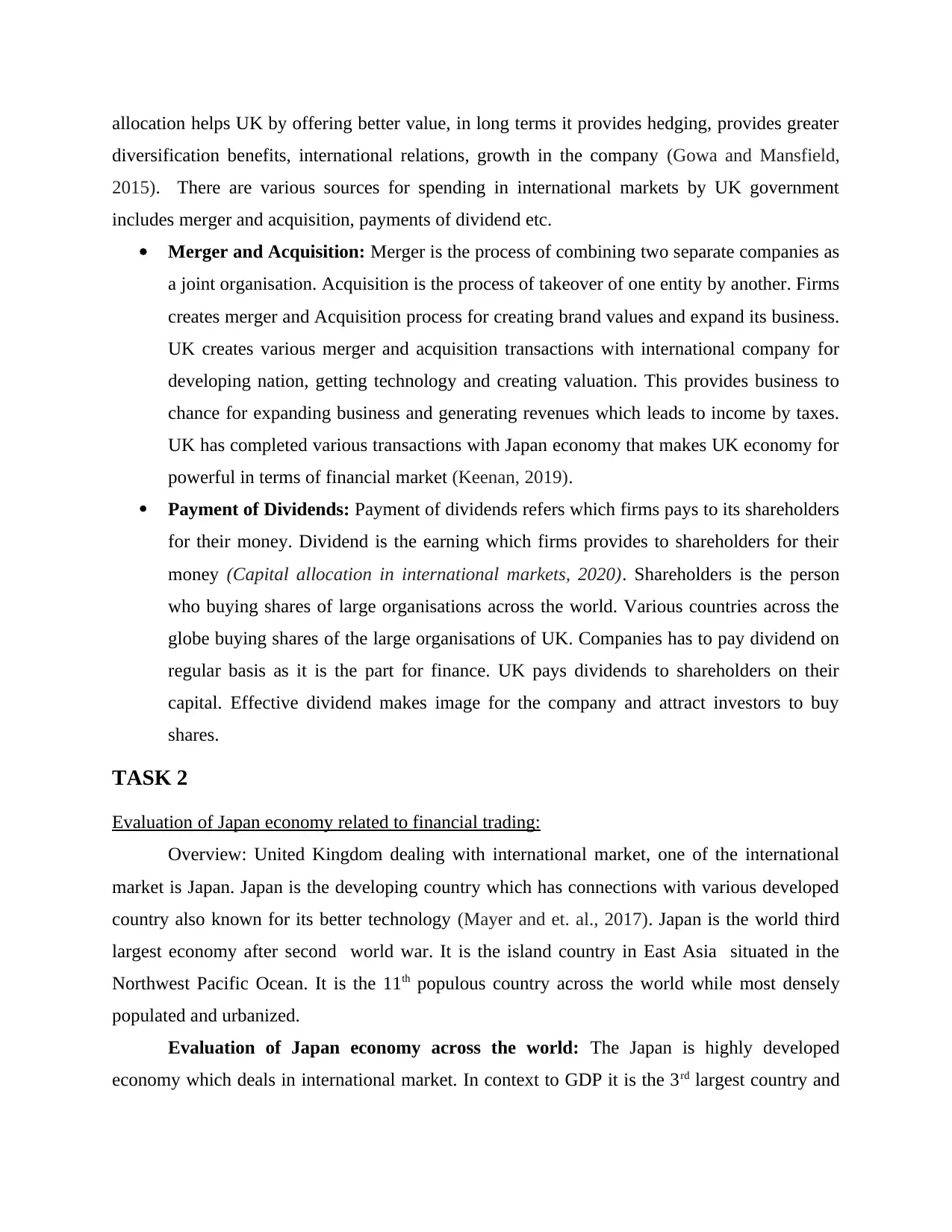
allocation helps UK by offering better value, in long terms it provides hedging, provides greater
diversification benefits, international relations, growth in the company (Gowa and Mansfield,
2015). There are various sources for spending in international markets by UK government
includes merger and acquisition, payments of dividend etc.
Merger and Acquisition: Merger is the process of combining two separate companies as
a joint organisation. Acquisition is the process of takeover of one entity by another. Firms
creates merger and Acquisition process for creating brand values and expand its business.
UK creates various merger and acquisition transactions with international company for
developing nation, getting technology and creating valuation. This provides business to
chance for expanding business and generating revenues which leads to income by taxes.
UK has completed various transactions with Japan economy that makes UK economy for
powerful in terms of financial market (Keenan, 2019).
Payment of Dividends: Payment of dividends refers which firms pays to its shareholders
for their money. Dividend is the earning which firms provides to shareholders for their
money (Capital allocation in international markets, 2020). Shareholders is the person
who buying shares of large organisations across the world. Various countries across the
globe buying shares of the large organisations of UK. Companies has to pay dividend on
regular basis as it is the part for finance. UK pays dividends to shareholders on their
capital. Effective dividend makes image for the company and attract investors to buy
shares.
TASK 2
Evaluation of Japan economy related to financial trading:
Overview: United Kingdom dealing with international market, one of the international
market is Japan. Japan is the developing country which has connections with various developed
country also known for its better technology (Mayer and et. al., 2017). Japan is the world third
largest economy after second world war. It is the island country in East Asia situated in the
Northwest Pacific Ocean. It is the 11th populous country across the world while most densely
populated and urbanized.
Evaluation of Japan economy across the world: The Japan is highly developed
economy which deals in international market. In context to GDP it is the 3rd largest country and
diversification benefits, international relations, growth in the company (Gowa and Mansfield,
2015). There are various sources for spending in international markets by UK government
includes merger and acquisition, payments of dividend etc.
Merger and Acquisition: Merger is the process of combining two separate companies as
a joint organisation. Acquisition is the process of takeover of one entity by another. Firms
creates merger and Acquisition process for creating brand values and expand its business.
UK creates various merger and acquisition transactions with international company for
developing nation, getting technology and creating valuation. This provides business to
chance for expanding business and generating revenues which leads to income by taxes.
UK has completed various transactions with Japan economy that makes UK economy for
powerful in terms of financial market (Keenan, 2019).
Payment of Dividends: Payment of dividends refers which firms pays to its shareholders
for their money. Dividend is the earning which firms provides to shareholders for their
money (Capital allocation in international markets, 2020). Shareholders is the person
who buying shares of large organisations across the world. Various countries across the
globe buying shares of the large organisations of UK. Companies has to pay dividend on
regular basis as it is the part for finance. UK pays dividends to shareholders on their
capital. Effective dividend makes image for the company and attract investors to buy
shares.
TASK 2
Evaluation of Japan economy related to financial trading:
Overview: United Kingdom dealing with international market, one of the international
market is Japan. Japan is the developing country which has connections with various developed
country also known for its better technology (Mayer and et. al., 2017). Japan is the world third
largest economy after second world war. It is the island country in East Asia situated in the
Northwest Pacific Ocean. It is the 11th populous country across the world while most densely
populated and urbanized.
Evaluation of Japan economy across the world: The Japan is highly developed
economy which deals in international market. In context to GDP it is the 3rd largest country and
⊘ This is a preview!⊘
Do you want full access?
Subscribe today to unlock all pages.

Trusted by 1+ million students worldwide
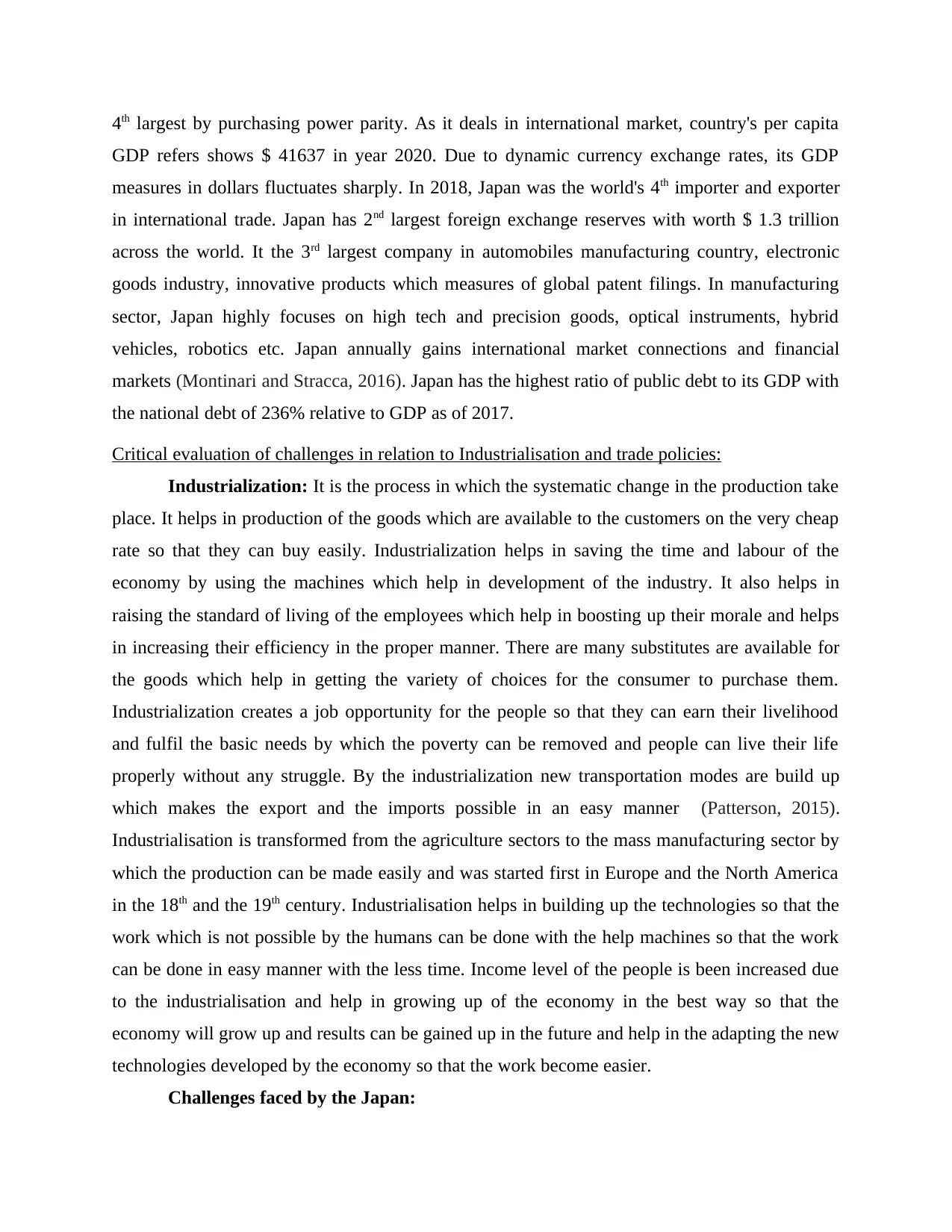
4th largest by purchasing power parity. As it deals in international market, country's per capita
GDP refers shows $ 41637 in year 2020. Due to dynamic currency exchange rates, its GDP
measures in dollars fluctuates sharply. In 2018, Japan was the world's 4th importer and exporter
in international trade. Japan has 2nd largest foreign exchange reserves with worth $ 1.3 trillion
across the world. It the 3rd largest company in automobiles manufacturing country, electronic
goods industry, innovative products which measures of global patent filings. In manufacturing
sector, Japan highly focuses on high tech and precision goods, optical instruments, hybrid
vehicles, robotics etc. Japan annually gains international market connections and financial
markets (Montinari and Stracca, 2016). Japan has the highest ratio of public debt to its GDP with
the national debt of 236% relative to GDP as of 2017.
Critical evaluation of challenges in relation to Industrialisation and trade policies:
Industrialization: It is the process in which the systematic change in the production take
place. It helps in production of the goods which are available to the customers on the very cheap
rate so that they can buy easily. Industrialization helps in saving the time and labour of the
economy by using the machines which help in development of the industry. It also helps in
raising the standard of living of the employees which help in boosting up their morale and helps
in increasing their efficiency in the proper manner. There are many substitutes are available for
the goods which help in getting the variety of choices for the consumer to purchase them.
Industrialization creates a job opportunity for the people so that they can earn their livelihood
and fulfil the basic needs by which the poverty can be removed and people can live their life
properly without any struggle. By the industrialization new transportation modes are build up
which makes the export and the imports possible in an easy manner (Patterson, 2015).
Industrialisation is transformed from the agriculture sectors to the mass manufacturing sector by
which the production can be made easily and was started first in Europe and the North America
in the 18th and the 19th century. Industrialisation helps in building up the technologies so that the
work which is not possible by the humans can be done with the help machines so that the work
can be done in easy manner with the less time. Income level of the people is been increased due
to the industrialisation and help in growing up of the economy in the best way so that the
economy will grow up and results can be gained up in the future and help in the adapting the new
technologies developed by the economy so that the work become easier.
Challenges faced by the Japan:
GDP refers shows $ 41637 in year 2020. Due to dynamic currency exchange rates, its GDP
measures in dollars fluctuates sharply. In 2018, Japan was the world's 4th importer and exporter
in international trade. Japan has 2nd largest foreign exchange reserves with worth $ 1.3 trillion
across the world. It the 3rd largest company in automobiles manufacturing country, electronic
goods industry, innovative products which measures of global patent filings. In manufacturing
sector, Japan highly focuses on high tech and precision goods, optical instruments, hybrid
vehicles, robotics etc. Japan annually gains international market connections and financial
markets (Montinari and Stracca, 2016). Japan has the highest ratio of public debt to its GDP with
the national debt of 236% relative to GDP as of 2017.
Critical evaluation of challenges in relation to Industrialisation and trade policies:
Industrialization: It is the process in which the systematic change in the production take
place. It helps in production of the goods which are available to the customers on the very cheap
rate so that they can buy easily. Industrialization helps in saving the time and labour of the
economy by using the machines which help in development of the industry. It also helps in
raising the standard of living of the employees which help in boosting up their morale and helps
in increasing their efficiency in the proper manner. There are many substitutes are available for
the goods which help in getting the variety of choices for the consumer to purchase them.
Industrialization creates a job opportunity for the people so that they can earn their livelihood
and fulfil the basic needs by which the poverty can be removed and people can live their life
properly without any struggle. By the industrialization new transportation modes are build up
which makes the export and the imports possible in an easy manner (Patterson, 2015).
Industrialisation is transformed from the agriculture sectors to the mass manufacturing sector by
which the production can be made easily and was started first in Europe and the North America
in the 18th and the 19th century. Industrialisation helps in building up the technologies so that the
work which is not possible by the humans can be done with the help machines so that the work
can be done in easy manner with the less time. Income level of the people is been increased due
to the industrialisation and help in growing up of the economy in the best way so that the
economy will grow up and results can be gained up in the future and help in the adapting the new
technologies developed by the economy so that the work become easier.
Challenges faced by the Japan:
Paraphrase This Document
Need a fresh take? Get an instant paraphrase of this document with our AI Paraphraser
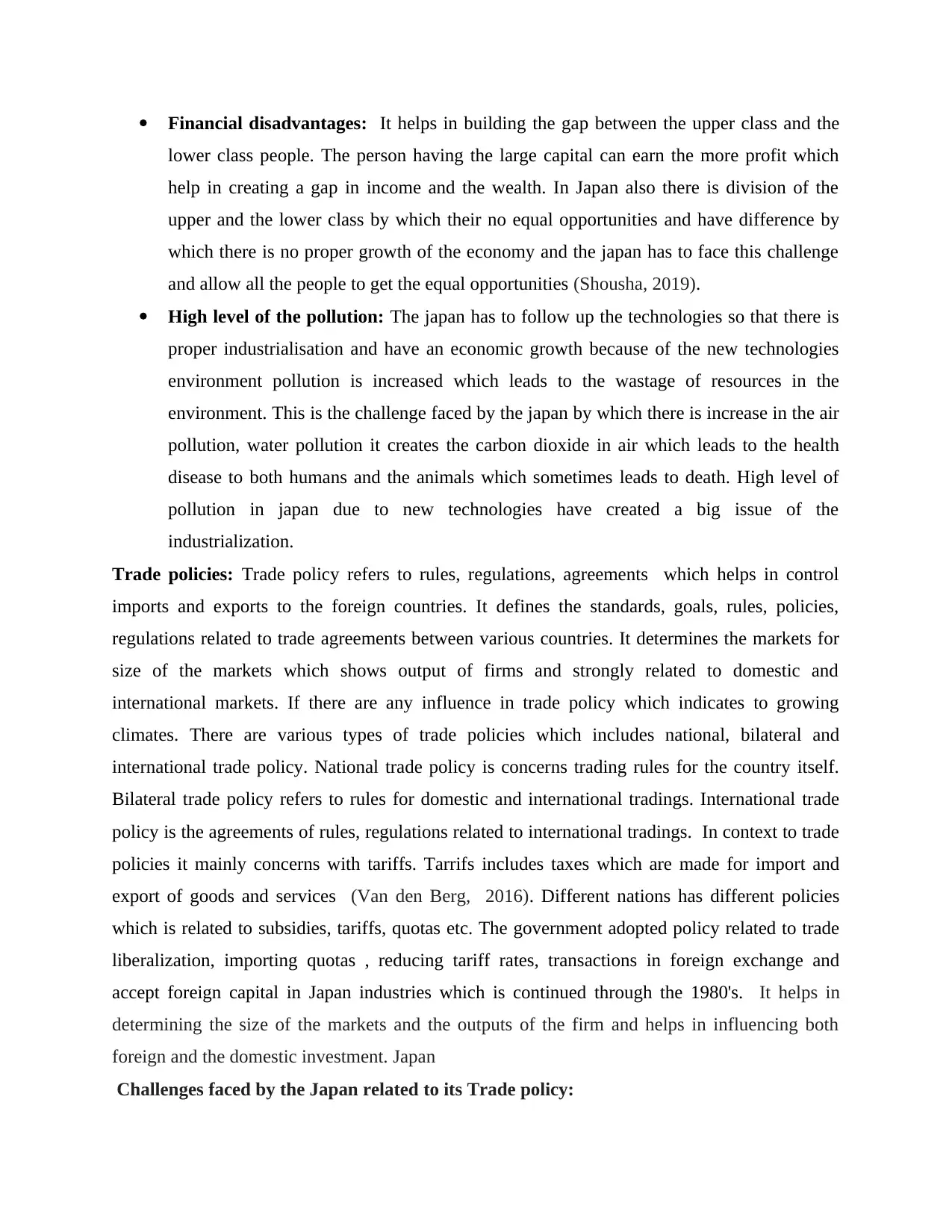
Financial disadvantages: It helps in building the gap between the upper class and the
lower class people. The person having the large capital can earn the more profit which
help in creating a gap in income and the wealth. In Japan also there is division of the
upper and the lower class by which their no equal opportunities and have difference by
which there is no proper growth of the economy and the japan has to face this challenge
and allow all the people to get the equal opportunities (Shousha, 2019).
High level of the pollution: The japan has to follow up the technologies so that there is
proper industrialisation and have an economic growth because of the new technologies
environment pollution is increased which leads to the wastage of resources in the
environment. This is the challenge faced by the japan by which there is increase in the air
pollution, water pollution it creates the carbon dioxide in air which leads to the health
disease to both humans and the animals which sometimes leads to death. High level of
pollution in japan due to new technologies have created a big issue of the
industrialization.
Trade policies: Trade policy refers to rules, regulations, agreements which helps in control
imports and exports to the foreign countries. It defines the standards, goals, rules, policies,
regulations related to trade agreements between various countries. It determines the markets for
size of the markets which shows output of firms and strongly related to domestic and
international markets. If there are any influence in trade policy which indicates to growing
climates. There are various types of trade policies which includes national, bilateral and
international trade policy. National trade policy is concerns trading rules for the country itself.
Bilateral trade policy refers to rules for domestic and international tradings. International trade
policy is the agreements of rules, regulations related to international tradings. In context to trade
policies it mainly concerns with tariffs. Tarrifs includes taxes which are made for import and
export of goods and services (Van den Berg, 2016). Different nations has different policies
which is related to subsidies, tariffs, quotas etc. The government adopted policy related to trade
liberalization, importing quotas , reducing tariff rates, transactions in foreign exchange and
accept foreign capital in Japan industries which is continued through the 1980's. It helps in
determining the size of the markets and the outputs of the firm and helps in influencing both
foreign and the domestic investment. Japan
Challenges faced by the Japan related to its Trade policy:
lower class people. The person having the large capital can earn the more profit which
help in creating a gap in income and the wealth. In Japan also there is division of the
upper and the lower class by which their no equal opportunities and have difference by
which there is no proper growth of the economy and the japan has to face this challenge
and allow all the people to get the equal opportunities (Shousha, 2019).
High level of the pollution: The japan has to follow up the technologies so that there is
proper industrialisation and have an economic growth because of the new technologies
environment pollution is increased which leads to the wastage of resources in the
environment. This is the challenge faced by the japan by which there is increase in the air
pollution, water pollution it creates the carbon dioxide in air which leads to the health
disease to both humans and the animals which sometimes leads to death. High level of
pollution in japan due to new technologies have created a big issue of the
industrialization.
Trade policies: Trade policy refers to rules, regulations, agreements which helps in control
imports and exports to the foreign countries. It defines the standards, goals, rules, policies,
regulations related to trade agreements between various countries. It determines the markets for
size of the markets which shows output of firms and strongly related to domestic and
international markets. If there are any influence in trade policy which indicates to growing
climates. There are various types of trade policies which includes national, bilateral and
international trade policy. National trade policy is concerns trading rules for the country itself.
Bilateral trade policy refers to rules for domestic and international tradings. International trade
policy is the agreements of rules, regulations related to international tradings. In context to trade
policies it mainly concerns with tariffs. Tarrifs includes taxes which are made for import and
export of goods and services (Van den Berg, 2016). Different nations has different policies
which is related to subsidies, tariffs, quotas etc. The government adopted policy related to trade
liberalization, importing quotas , reducing tariff rates, transactions in foreign exchange and
accept foreign capital in Japan industries which is continued through the 1980's. It helps in
determining the size of the markets and the outputs of the firm and helps in influencing both
foreign and the domestic investment. Japan
Challenges faced by the Japan related to its Trade policy:
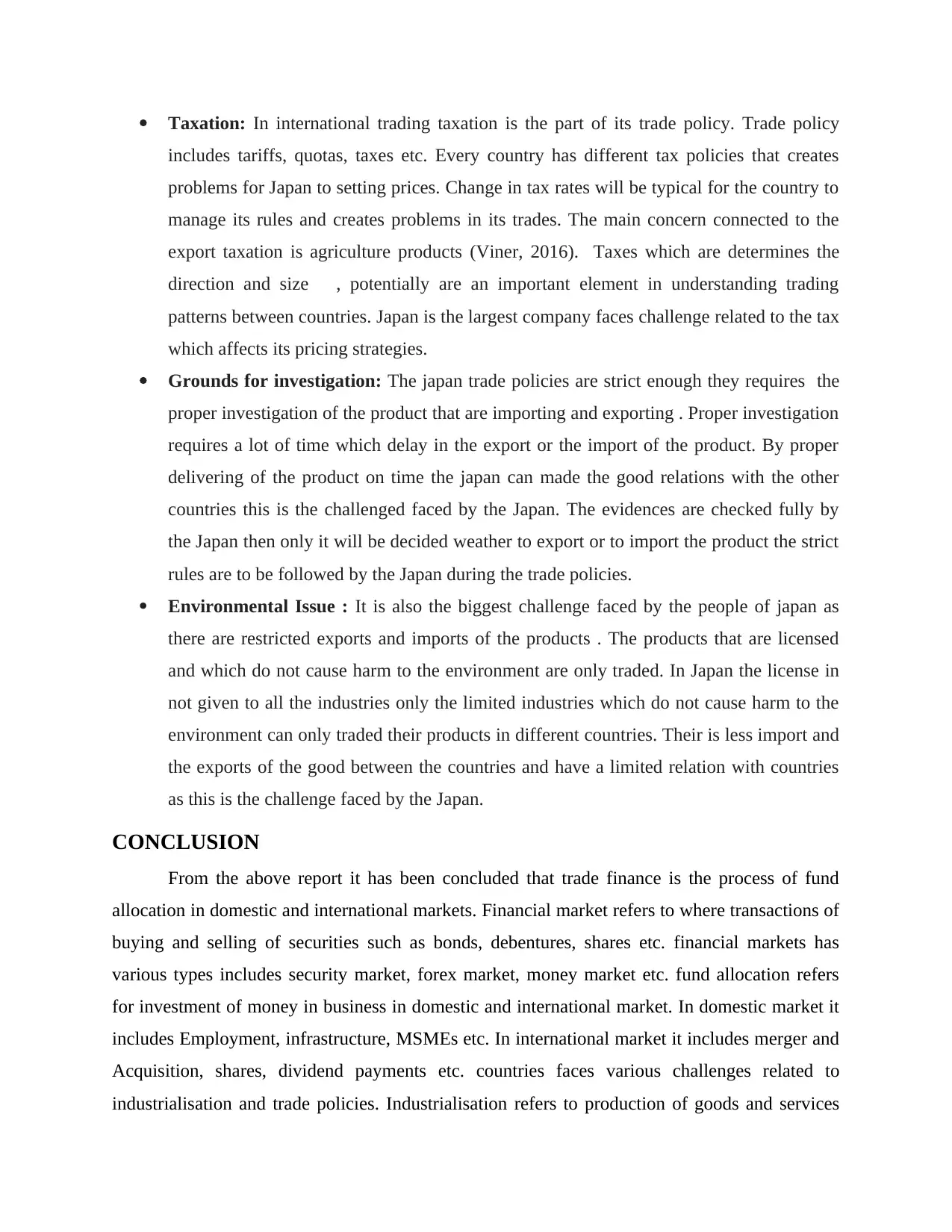
Taxation: In international trading taxation is the part of its trade policy. Trade policy
includes tariffs, quotas, taxes etc. Every country has different tax policies that creates
problems for Japan to setting prices. Change in tax rates will be typical for the country to
manage its rules and creates problems in its trades. The main concern connected to the
export taxation is agriculture products (Viner, 2016). Taxes which are determines the
direction and size , potentially are an important element in understanding trading
patterns between countries. Japan is the largest company faces challenge related to the tax
which affects its pricing strategies.
Grounds for investigation: The japan trade policies are strict enough they requires the
proper investigation of the product that are importing and exporting . Proper investigation
requires a lot of time which delay in the export or the import of the product. By proper
delivering of the product on time the japan can made the good relations with the other
countries this is the challenged faced by the Japan. The evidences are checked fully by
the Japan then only it will be decided weather to export or to import the product the strict
rules are to be followed by the Japan during the trade policies.
Environmental Issue : It is also the biggest challenge faced by the people of japan as
there are restricted exports and imports of the products . The products that are licensed
and which do not cause harm to the environment are only traded. In Japan the license in
not given to all the industries only the limited industries which do not cause harm to the
environment can only traded their products in different countries. Their is less import and
the exports of the good between the countries and have a limited relation with countries
as this is the challenge faced by the Japan.
CONCLUSION
From the above report it has been concluded that trade finance is the process of fund
allocation in domestic and international markets. Financial market refers to where transactions of
buying and selling of securities such as bonds, debentures, shares etc. financial markets has
various types includes security market, forex market, money market etc. fund allocation refers
for investment of money in business in domestic and international market. In domestic market it
includes Employment, infrastructure, MSMEs etc. In international market it includes merger and
Acquisition, shares, dividend payments etc. countries faces various challenges related to
industrialisation and trade policies. Industrialisation refers to production of goods and services
includes tariffs, quotas, taxes etc. Every country has different tax policies that creates
problems for Japan to setting prices. Change in tax rates will be typical for the country to
manage its rules and creates problems in its trades. The main concern connected to the
export taxation is agriculture products (Viner, 2016). Taxes which are determines the
direction and size , potentially are an important element in understanding trading
patterns between countries. Japan is the largest company faces challenge related to the tax
which affects its pricing strategies.
Grounds for investigation: The japan trade policies are strict enough they requires the
proper investigation of the product that are importing and exporting . Proper investigation
requires a lot of time which delay in the export or the import of the product. By proper
delivering of the product on time the japan can made the good relations with the other
countries this is the challenged faced by the Japan. The evidences are checked fully by
the Japan then only it will be decided weather to export or to import the product the strict
rules are to be followed by the Japan during the trade policies.
Environmental Issue : It is also the biggest challenge faced by the people of japan as
there are restricted exports and imports of the products . The products that are licensed
and which do not cause harm to the environment are only traded. In Japan the license in
not given to all the industries only the limited industries which do not cause harm to the
environment can only traded their products in different countries. Their is less import and
the exports of the good between the countries and have a limited relation with countries
as this is the challenge faced by the Japan.
CONCLUSION
From the above report it has been concluded that trade finance is the process of fund
allocation in domestic and international markets. Financial market refers to where transactions of
buying and selling of securities such as bonds, debentures, shares etc. financial markets has
various types includes security market, forex market, money market etc. fund allocation refers
for investment of money in business in domestic and international market. In domestic market it
includes Employment, infrastructure, MSMEs etc. In international market it includes merger and
Acquisition, shares, dividend payments etc. countries faces various challenges related to
industrialisation and trade policies. Industrialisation refers to production of goods and services
⊘ This is a preview!⊘
Do you want full access?
Subscribe today to unlock all pages.

Trusted by 1+ million students worldwide

available for cheaper price. Trade policy concerns with rules, regulations for exporting and
importing goods and services by the countries.
importing goods and services by the countries.
Paraphrase This Document
Need a fresh take? Get an instant paraphrase of this document with our AI Paraphraser
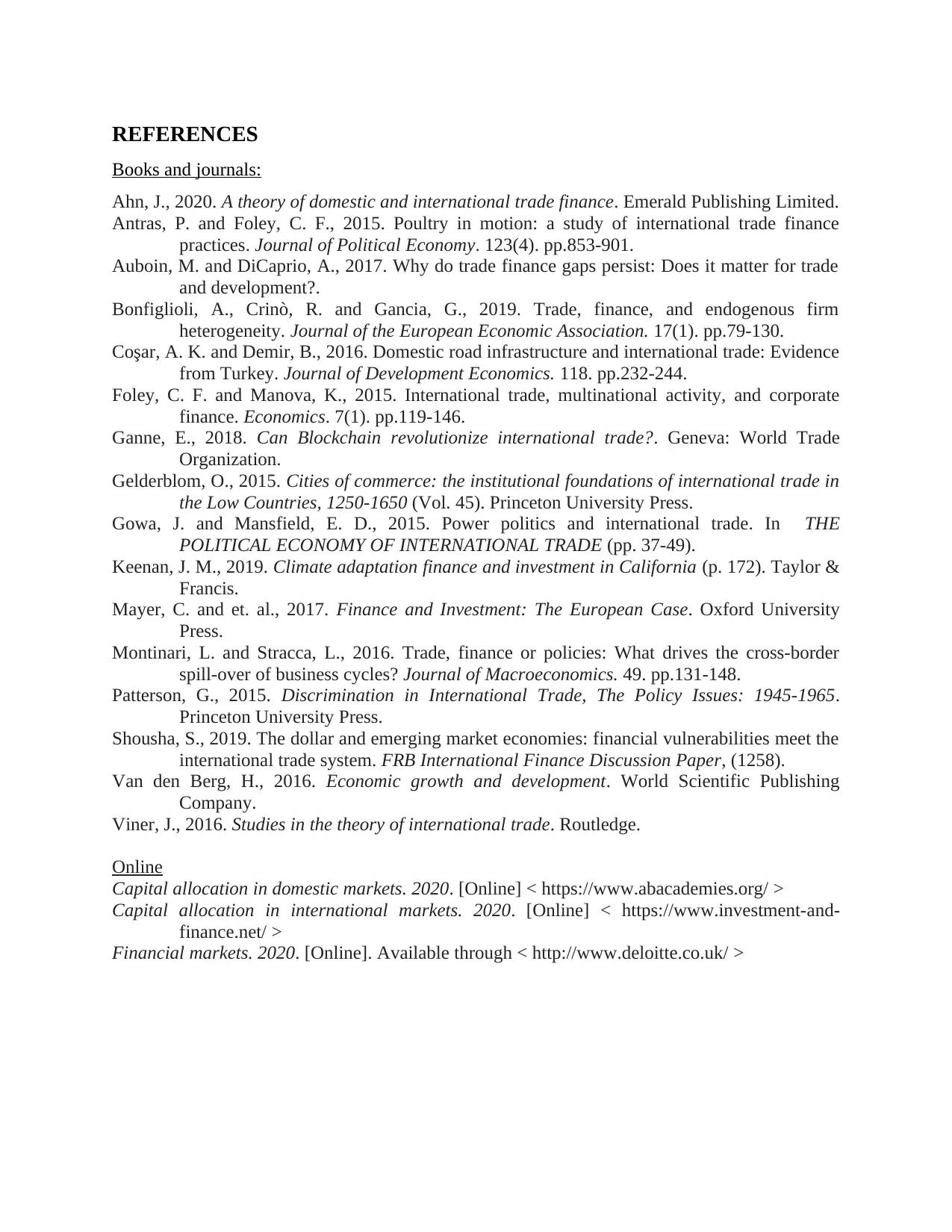
REFERENCES
Books and journals:
Ahn, J., 2020. A theory of domestic and international trade finance. Emerald Publishing Limited.
Antras, P. and Foley, C. F., 2015. Poultry in motion: a study of international trade finance
practices. Journal of Political Economy. 123(4). pp.853-901.
Auboin, M. and DiCaprio, A., 2017. Why do trade finance gaps persist: Does it matter for trade
and development?.
Bonfiglioli, A., Crinò, R. and Gancia, G., 2019. Trade, finance, and endogenous firm
heterogeneity. Journal of the European Economic Association. 17(1). pp.79-130.
Coşar, A. K. and Demir, B., 2016. Domestic road infrastructure and international trade: Evidence
from Turkey. Journal of Development Economics. 118. pp.232-244.
Foley, C. F. and Manova, K., 2015. International trade, multinational activity, and corporate
finance. Economics. 7(1). pp.119-146.
Ganne, E., 2018. Can Blockchain revolutionize international trade?. Geneva: World Trade
Organization.
Gelderblom, O., 2015. Cities of commerce: the institutional foundations of international trade in
the Low Countries, 1250-1650 (Vol. 45). Princeton University Press.
Gowa, J. and Mansfield, E. D., 2015. Power politics and international trade. In THE
POLITICAL ECONOMY OF INTERNATIONAL TRADE (pp. 37-49).
Keenan, J. M., 2019. Climate adaptation finance and investment in California (p. 172). Taylor &
Francis.
Mayer, C. and et. al., 2017. Finance and Investment: The European Case. Oxford University
Press.
Montinari, L. and Stracca, L., 2016. Trade, finance or policies: What drives the cross-border
spill-over of business cycles? Journal of Macroeconomics. 49. pp.131-148.
Patterson, G., 2015. Discrimination in International Trade, The Policy Issues: 1945-1965.
Princeton University Press.
Shousha, S., 2019. The dollar and emerging market economies: financial vulnerabilities meet the
international trade system. FRB International Finance Discussion Paper, (1258).
Van den Berg, H., 2016. Economic growth and development. World Scientific Publishing
Company.
Viner, J., 2016. Studies in the theory of international trade. Routledge.
Online
Capital allocation in domestic markets. 2020. [Online] < https://www.abacademies.org/ >
Capital allocation in international markets. 2020. [Online] < https://www.investment-and-
finance.net/ >
Financial markets. 2020. [Online]. Available through < http://www.deloitte.co.uk/ >
Books and journals:
Ahn, J., 2020. A theory of domestic and international trade finance. Emerald Publishing Limited.
Antras, P. and Foley, C. F., 2015. Poultry in motion: a study of international trade finance
practices. Journal of Political Economy. 123(4). pp.853-901.
Auboin, M. and DiCaprio, A., 2017. Why do trade finance gaps persist: Does it matter for trade
and development?.
Bonfiglioli, A., Crinò, R. and Gancia, G., 2019. Trade, finance, and endogenous firm
heterogeneity. Journal of the European Economic Association. 17(1). pp.79-130.
Coşar, A. K. and Demir, B., 2016. Domestic road infrastructure and international trade: Evidence
from Turkey. Journal of Development Economics. 118. pp.232-244.
Foley, C. F. and Manova, K., 2015. International trade, multinational activity, and corporate
finance. Economics. 7(1). pp.119-146.
Ganne, E., 2018. Can Blockchain revolutionize international trade?. Geneva: World Trade
Organization.
Gelderblom, O., 2015. Cities of commerce: the institutional foundations of international trade in
the Low Countries, 1250-1650 (Vol. 45). Princeton University Press.
Gowa, J. and Mansfield, E. D., 2015. Power politics and international trade. In THE
POLITICAL ECONOMY OF INTERNATIONAL TRADE (pp. 37-49).
Keenan, J. M., 2019. Climate adaptation finance and investment in California (p. 172). Taylor &
Francis.
Mayer, C. and et. al., 2017. Finance and Investment: The European Case. Oxford University
Press.
Montinari, L. and Stracca, L., 2016. Trade, finance or policies: What drives the cross-border
spill-over of business cycles? Journal of Macroeconomics. 49. pp.131-148.
Patterson, G., 2015. Discrimination in International Trade, The Policy Issues: 1945-1965.
Princeton University Press.
Shousha, S., 2019. The dollar and emerging market economies: financial vulnerabilities meet the
international trade system. FRB International Finance Discussion Paper, (1258).
Van den Berg, H., 2016. Economic growth and development. World Scientific Publishing
Company.
Viner, J., 2016. Studies in the theory of international trade. Routledge.
Online
Capital allocation in domestic markets. 2020. [Online] < https://www.abacademies.org/ >
Capital allocation in international markets. 2020. [Online] < https://www.investment-and-
finance.net/ >
Financial markets. 2020. [Online]. Available through < http://www.deloitte.co.uk/ >

⊘ This is a preview!⊘
Do you want full access?
Subscribe today to unlock all pages.

Trusted by 1+ million students worldwide
1 out of 12
Related Documents
Your All-in-One AI-Powered Toolkit for Academic Success.
+13062052269
info@desklib.com
Available 24*7 on WhatsApp / Email
![[object Object]](/_next/static/media/star-bottom.7253800d.svg)
Unlock your academic potential
Copyright © 2020–2025 A2Z Services. All Rights Reserved. Developed and managed by ZUCOL.





